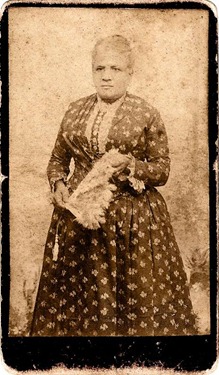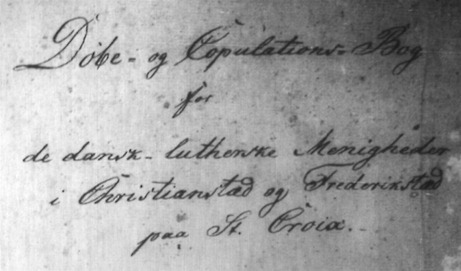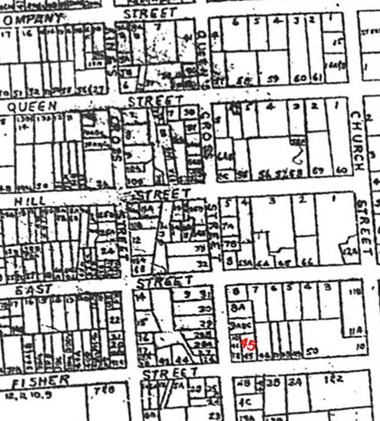 |
| Amy McNobney's Slave Tax Document from 1800 |
This genealogy blog shares my Virgin Islands family. I cover general VI records and family history sources, social history, island history, and genealogy techniques and hints. Surnames include van Beverhoudt, Conrad, Magens, De Windt, Pentheny, Colbeth, Moorhead, Robson, Andersen, Scott, Dalton, and related families.
Saturday, October 29, 2011
Children of Amy McNobney
Monday, October 24, 2011
Photos: Cartes-de-visite (CDVs)
 |
| Louisa van Beverhoudt, 1890 |
Friday, October 21, 2011
Profile: Mary Conrad Simonsen
Thursday, October 20, 2011
Treasures from Mom’s House
My grandmother Olga was something of a packrat. When I was little we visited her in her house on Strand St. in Christiansted. She had all kinds of stuff around, papers, knickknacks, odds, ends, everything a little boy could want. She used to tell me she had a “Curiosity Shoppe”. When she died, it took two trips to the island to sort things into what to ship, what to give away, and what to donate. Fortunately, my mother kept the photos. Boxes of them. That was 25 years ago. Last night, we opened the boxes …
…
Wednesday, October 19, 2011
Dealing with Bad Images
As you know if you’re following this blog, I’m working with microfilm images. After I collect them I usually have to do some image manipulation. Sometimes I just have to attach facing pages that have been scanned as separate frames and sometimes microfilms can be difficult to read due to darkening or lightening of the original document. Here’s where scanning can be a real help. This is a marriage record from 1820 of a Gertruyd van Beverhoudt (don’t know if she’s family yet). As you can see, it’s very dark.
Monday, October 17, 2011
My Lutheran Family
 |
| Title Page from Baptismal Record from 1828-1860 |
Saturday, October 15, 2011
Blogging for Cousins
Tuesday, October 11, 2011
I Found My Great-Great Grandfather
Today I made a great find at the Family History Center. I located my 2nd great grandfather. This was a brick wall that I have been struggling with virtually from Day 1 of my genealogical journey. I got started on this hobby (obsession) by chancing across an on-line database, the Danish Demographic Database (Dansk Demografisk Database). This is a free searchable database of Danish censuses and church records. They have a link to the St. Croix Census records on their site. By querying this I found my grandfather (Ludvig Conrad), great grandfather (Christian Andreas Conrad), and his mother (Sophia Andersen). No father. No Conrad. I searched the VISHA database and Ancestry.com. Try as I might, I couldn’t locate a Conrad to be the source of that family name. No Conrad appeared in any census that would fit.
Sunday, October 9, 2011
A Great Find
The problem is that addresses tend to be unimportant in Christiansted. Even current residents don’t know the house numbers. Even Google Maps didn’t know. It finds the street, but not the number. I had tried every way I could think of, even posting a question to the St. Croix Message board at Ancestry.com
All this got resolved with my email. The St. Croix Landmarks Society just sent me a scan of a US Government Public Works map entitled “Old Limits of Christiansted Town” with each unit marked and numbered. The map is undated, but since it is a US Government map, it must have been after 1917.

Saturday, October 8, 2011
My Microfilm’s In–An Offer for Readers
I just found out that the microfilm roll I ordered from the FHL is in. It is the Lutheran church records for St Croix (FHL INTL Film 38861) covering:
- Baptisms 1797-1865
- Confirmations 1788-1860
- Marriages 1788-1864
- Burials 1788-1822
- Communicants 1805-1818
Given the number of Lutherans in my van Beverhoudt family, this may be a gold mine, and it may be a dud. I’m hopeful for the latter. I figure it will take me a while to get through the roll, given the time it took to go through the Anglican records posted by FamilySearch.org, so if I’m doing the time perhaps I can help someone else too.
If you think your ancestor might be on this roll, please let me know what to look for so I can keep an eye out for it. I’ll need to know the names and approximate dates, and which section (baptism, marriage, etc.) I should look in. If I can, I’ll try to get a scan of the relevant pages.
I’ll start at the beginning and go to the end either way, and after I finish this roll, I’ll order another (unless I find that my family didn’t go to that church). The collection is 4 rolls.
I’m hoping to get started Monday Oct 10, so let me know if you want me to look for something.
Wednesday, October 5, 2011
Case Study: Adelaide’s Maiden Name
The Problem
My great grandmother’s name was Hester Franklin van Beverhoudt (isn’t that a strange middle name for a girl?). I found her in the 1860 census, age 3, living with her father Claudius and mother, Adelaide. Adelaide and Claudius were listed as married in both the 1855 and 1857 censuses. The question was, how to find Adelaide’s maiden name.Monday, October 3, 2011
Anglican Church Records at FamilySearch.org
A visitor to my blog suggested that I talk about the sources I'm looking at in my own research to share what's out there and perhaps give some commentary on the sources. That sounded like a good idea, so I'll start with the most recent collection I've been viewing.
FamilySearch.org is the on-line presence of the Family History Library (FHL) of the Church of Jesus Christ of Latter Day Saints (LDS). Among other things, the new FamilySearch site hosts browsable images of VI church records. On September 7, 2011 they added a collection of Anglican church records from St Croix for both St John's Episcopal Anglican in Christiansted and St Paul's in Frederiksted. These records are organized into groups of Baptism, Marriage, Confirmation, and Burials spanning 1765-2009. This is quite a large collection of images of the church registers. Most of them appear to be originals, even showing editorial comments (such as payments for baptisms). Since, as I showed in my earlier post, Anglican was the largest denomination on the island, these are quite valuable resources for genealogy...
